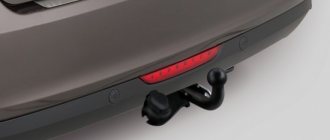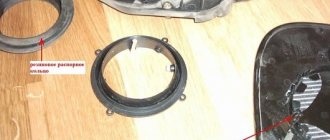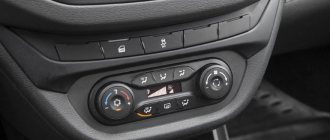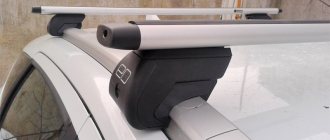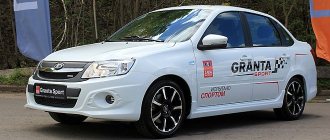AvtoVAZ presented new models to the public: Lada Granta and Lada Vesta Sport 1.8. It is planned that serial production of the Lada Vesta Sport 1.8 model will begin in February 2022, and will go on sale in April. I would like to note that the production Vesta Sport is no different from the concept presented in 2016.
Exterior
Externally, the model is still similar to the standard Lada Vesta. The sports version is different: a new body kit, spoiler, and red lining. The set includes 17-inch alloy wheels with new hubs (5×100), the wheel arches have become larger, and the ground clearance has become lower compared to the standard model (162 mm).
Interior
There aren't many changes inside either. The new seats with pronounced lateral support are striking, there are pedal pads, a front armrest, pads in the doorways, and a black roof lining. There is also red interior lighting.
Lada Vesta Sport technical specifications
Under the hood is an updated version of the 1.8 liter engine. (21179). Due to the installation of new camshafts, higher pressure in the fuel rail, and debugging of the ECU program, it was possible to increase the power from 122 to 145 hp, and the torque increased to 187 Nm.
Someone will say that it is high time for AvtoVAZ to start developing and producing turbocharged engines, but we are content with what we have. Thanks to the installation of different springs and shock absorbers, the suspension became stiffer. The brake discs, pistons and pads have also been enlarged - all this makes braking more confident.
Except for the height, all dimensions remain the same:
- Length - 4420 mm
- Width - 1774 mm
- Height - 1478 mm
- Wheelbase - 2635 mm
- Ground clearance - 162 mm
Manual transmission Renault jr5
The “Sport” version will be equipped only with a 5-speed manual transmission from Renault (JR5-523), they decided to abandon the automatic transmission. There are rumors that it is planned to install a Japanese CVT from Jatco in the future.
avtoexperts.ru
AvtoVAZ has extensive experience in creating pseudo-sports cars. “Nine”, “Ten”, “Kalina” - all Togliatti bestsellers had such versions. This is not a real sport, but a small hint of it. The sports “ten” stood out especially strongly, which was even equipped with a two-liter GM engine. True, Kalina was mostly distinguished by its body kit, and not by real technical improvements, but still. Vesta also begged to “go into sports”, and three years after the release of the basic model, this version appeared. Fortunately, this time in Togliatti they didn’t get by with just cosmetics; the difference between the Sport and the base car is quite large - according to engineers’ calculations, more than two hundred components and elements were replaced, which really made it possible to change the character of the car compared to the usual Vesta. Are all these improvements necessary and does it make sense to buy a Lada, the price of which has exceeded a million (we will discuss prices later, of course) - let’s look into this material.
Lada Vesta Sport
Motor
Sport begins with an increase in power, so the first modification of the Lada Vesta Sport is the engine. Nothing extraordinary happened. The engineers took a standard 1.8 engine, changed its camshafts, adjusted the intake and exhaust, and tinkered with the firmware. As a result, power increased from 122 to 145, torque increased not so significantly, but there is an increase here too - from 170 to 182 Nm. Compared to the base Vesta, the Lada Vesta Sport has become more dynamic, the more linear and competent adjustment of the gas pedal is especially valuable - the engine not only pulls better, but also responds more clearly to fuel dosing, this makes driving smoother and more comfortable.
Engine 1.8 VAZ-21179
It seems good that we managed to increase the power, but the engine is still considered perhaps the main disappointment of the Lada Vesta Sport. Even the original unit did not please with its crazy dynamics, losing, for example, to the Korean 1.6; one cannot expect much from the modernized version either. Yes, the Koreans are already behind us, but still the acceleration to hundreds is barely more than 10 seconds. At the same time, there are Volkswagen Polo and Skoda Rapid on sale with a 1.4 turbo engine, which, without any modifications, accelerate to 100 km/h in 9 seconds and drive away from the Lada Vesta Sport without any strain. And they cost less.
Of course, under the hood of the Lada Vesta Sport a turbo engine with 200 horsepower suggests itself, but VAZ doesn’t have it. Yes, and there would have been, but they wouldn’t have installed it. For such an engine, half of the car needs to be replaced, because of which the already considerable price would increase by one and a half times, so Lada Vesta Sport owners can drive with what they have, or modify it themselves.
Transmission
Lada Vesta Sport is equipped with a Renault JR5 gearbox, like the regular Vesta 1.8, Largus and a bunch of Renault models. The gearbox has average clarity of engagement and selectivity of the mechanism, it likes to “howl” in third gear (although, of course, not as much as the original VAZ one in second) and it has huge shift strokes. In general, this is not a very good option for sports; it is difficult to work quickly with such a “stirrer”. There is another problem - there are only five gears, they turned out to be stretched, which hides the dynamics.
Manual transmission JR5
But there is no other box and is not expected. Not only is the original VAZ car worse, it will also not be able to handle the torque of the new engine, and the same applies to the AMT. You can also forget about the CVT, which seems to be installed on regular Vestas from the end of this year: they are equipped only with HR16 engines, which are not adapted for Vesta Sport, and are inferior in power to the modernized 1.8.
How can we not remember again the Volkswagen Polo and Skoda Rapid with a 7-speed “robot”. Yes, there are complaints about its service life and reliability, but at least the comfort is beyond doubt. And in addition, the Polo also has an option with a successful “mechanics”, and a 6-speed one at that. And again, they are cheaper again.
Suspension
Even the basic Vesta has a good chassis in terms of handling, but for the Sport version it has been further refined. The ground clearance decreased to 145 millimeters, new shock absorbers appeared, from a different supplier, the castor became one and a half degrees larger, steering knuckles of a different design appeared, the hubs changed, and they are now designed for 5 bolts in the disk, the rear suspension received negative camber, both the front and The rear tracks have become wider. In addition, the car now has ContiSportContact 5 tires.
Tires size 205/50 R17
Did the changes work? Still would. While maintaining the basic energy intensity of the suspension, the Lada Vesta Sport has noticeably improved its handling, the car corners well and responds well to changes in the steering wheel position. In order to get complete driving pleasure, the Lada Vesta Sport is equipped with a complete shutdown of ESP (the base Vesta does not have it), so you can skillfully take turns sideways in the Lada Vesta Sport. The directional stability has significantly improved; if the regular Vesta starts to walk on a straight line after 120 km/h, then the Lada Vesta Sport stands like a rock. Only a strong side wind can knock it off course.
Lada Vesta Sport in motion
In terms of chassis, the Lada Vesta Sport is not only on par with its competitors in the relatively budget segment, but also superior to them. We weren't the only ones who came up with the idea of comparing the Lada Vesta Sport with the turbocharged Volkswagen Polo and Skoda Rapid - some bloggers made such a comparison on real race tracks. The results clearly demonstrate the strengths of all models. Volkswagen and Skoda, due to their faster engines, were able to get away on the straights, but the Lada Vesta Sport was catching up due to faster cornering. The final gap, although in favor of foreign cars, is very small.
However, for civilian use the new suspension has become less comfortable. Yes, it has retained the same energy intensity, that is, you can rush along broken asphalt without fear, but there is less comfort on small irregularities - shaking has appeared at the joints of the asphalt, and irregularities are transmitted more strongly to the cabin. Let’s not call this a minus: a person who buys a car with improved handling must understand that nothing happens for nothing and at some points you will have to pay for great reactions to the steering wheel and precise behavior in corners.
The increase in engine power was reflected in other technical elements. In particular, the brakes have become more powerful. The diameter of the front discs has increased from 260 to 300 mm, there is more steel and brake pads. The rear discs are the same as on regular Vestas, but at least they are there - a kind of achievement for AvtoVAZ.
Exterior and interior
From a marketing point of view, it would be stupid to launch a sports version with exactly the same appearance as the regular car. Therefore, the appearance of the Lada Vesta Sport was spoiled. There are new bumpers, extended front fenders made of plastic, a spoiler on the trunk lid, red inserts in the bumper, new rims and additional slots for aerodynamics. Engineers say that the body kit is not only for beauty, but also increases downforce, which also contributes to handling.
In general, the Lada Vesta Sport is a good example of how you can refresh the design a little for little money - it seems like the basic car is recognizable without problems, but at the same time it is clear that this is some kind of Vesta. Surely this will be an important factor for the psychological peace of mind of the owners who paid not 700-800 thousand rubles for Vesta, but more than a million - at least you will stand out a little from the crowd.
One interesting thing is that AvtoVAZ copied the function of many Volkswagen cars: when you turn the steering wheel, the fog light on the same side lights up and, as it were, illuminates the turn. On the one hand, this is a convenient function that does not increase the cost of the car, on the other hand, in the case of Vesta, this function turned out to be rather stupid: the car has good standard headlights, but weak foglights; when they are turned on, the light does not become larger and night visibility does not improve. But the attempt still counts.
Fog lights
They also tried to retouch the interior a little. But this issue turned out to be more confused. Various kinds of inserts, both in the seats and in the tidy, are more likely to distract than create a complete image, and the finishing materials are still the same as those of the base Vesta - cheap and hard. The build quality remains at approximately the same level - it is clear that the interior lacks a certain foreign-made gloss. But there are also useful new products.
Interior
Firstly, the new seats are definitely more comfortable than those in a regular car; they have longer cushions and more lateral support. Secondly, the leather steering wheel with red stitching is very pleasant to the touch, although it is still not heated. For rear passengers there is no difference between the regular Vesta and Lada Vesta Sport.
Sports chairs
Price
Here is the most interesting point. The price itself won’t tell you anything; everything can be learned by comparison, so let’s compare.
There is not much choice in terms of equipment - without multimedia, the Lada Vesta Sport costs 1,014,900 rubles at the time of writing, and with it - 1,050,900 rubles. The equipment is rich and corresponds to the regular Vesta in the Luxe configuration. For comparison, Vesta in the Luxe configuration at the time of writing costs 816,000 rubles without multimedia and 823,900 rubles with it. It turns out that the overpayment for sportiness is slightly less than 200 thousand rubles. Is it worth it? 200 thousand rubles is a decent amount for the budget segment, consider 20% of the cost, but the improvements are still noticeable - the engine is more powerful, the appearance is more interesting, the seats are normal, and the chassis and brakes are absolutely magnificent. So the choice between the regular Vesta and Vesta Sport is not so simple; even for everyday use, Vesta Sport has its advantages.
Lada Vesta Sport vs Skoda Rapid. Photo — auto.mail.ru
However, with the already mentioned Volkswagen Polo and Skoda Rapid, the price comparison is no longer so optimistic. A manual Volkswagen Polo 1.4 TSI costs from 850 thousand rubles. Yes, the equipment will be very poor, but such cars exist, unlike Vesta. In terms of money comparable to the Lada Vesta Sport, the equipment of the German and Czech will not lose much. At the same time, they have better dynamics, lower consumption, a more comfortable gearbox (and the “mechanics” are more interesting, and the “robot” is normal), and the Polo is certainly better in terms of build quality and interior. The Lada Vesta Sport has a more comfortable and energy-efficient chassis, as well as a more spacious interior, but we are not sure that this can compensate for the shortcomings. For everyday civilian use, engine power is much more interesting than refined handling, the advantages of the chassis will only be visible on the race track, and for ordinary driving the characteristics of Polo and Rapid seem more harmonious.
We don’t pretend to be the ultimate truth, but for drivers who just want to drive fast for relatively little money, cars with TSI 1.4 seem preferable. But we cannot help but admit that the Lada Vesta Sport is an excellent template for building a racing car. We already have an excellent chassis - install a turbine, chip it, lighten it, and you can already participate in serious racing. But this will not be of interest to everyone.
Reviews
| № | Positive |
| 1. | Vasily: Vesta in its basic configuration has proven itself on the positive side; few people complain about the quality. It's a pity that the same cannot be said about the Lada Granta. I am sure that the new models will be much better than the previous ones. |
| 2. | Dmitry: I am proud of the domestic manufacturer. Cars in an affordable price segment, a wide selection of spare parts. Breakdowns happen, it’s no secret, but they can be easily fixed on your own. |
| 3. | Kirill: my car is six months old, I bought it from scratch at the dealership. Apart from replacing consumables, I did not make any investments. Our people have finally learned how to make cars. Lada Vesta - my recommendations for motorists. |
| 4. | Gennady: new models of the domestic brand are good, both in price and in quality. Prices are affordable for families with an average budget. The assembly is several times better than Grants, Kalinas, Largus. |
| 5. | Vladislav: I’ve been actively using the car for a year, I have no complaints, all the mechanisms work properly. I believe that the most important thing for a car is systematic care and maintenance. |
| 6. | Konstantin: my positive review of the Lada Vesta, I purchased the model a year ago. During this time I only changed the oil and filled up with fuel. |
| 7. | Vladimir: I thought for a long time about what to buy, my comrades convinced me to take a domestic manufacturer. I'm happy with the solution, no complaints. |
| Negative | |
| 1. | Victor: despite the small breakthrough of the Russian manufacturer, the quality of workmanship remained at the same level. The basic Lada models are generally meager, no bells and whistles, you have to buy everything yourself. |
| 2. | Vasily: I thought about buying a Vesta, but my friends dissuaded me from buying a Renault Logan. I'm happy with the choice, no comments. |
| 3. | Dmitry: after a year of active use, the car begins to crumble. I have already visited a service station twice unscheduled for diagnostics and repairs. |
Related link:
Recommendations from experts on choosing fog lights for Lada Vesta
Motor 21179
For those who want to get better dynamics, or for those who are considering purchasing a version of the SV Cross, which is heavier, it is better to consider the motor 21179 , which has the following characteristics:
- fuel - gasoline;
- volume – 1.8 liters;
- power – 122 forces;
- torque – 170 Nm.
Let's look at some passport numbers from AvtoVAZ for this engine, however, they may vary depending on which version of Vesta it is installed in. The engine accelerates to 100 km/h in an average of just over 10 seconds. The engine shows maximum speed at approximately 186 kilometers per hour. Average consumption:
- city - 9.5 liters;
- highway - 6.2 liters;
- combined mode - 7.4 liters.
The power unit is also paired with a five-speed manual transmission, however, here the manufacturer decided not to use its own gearbox, but to install an option from Renault-Nissan.
This is the first engine of a domestic manufacturer to feature a mechanism for adjusting valve timing, with a phase shifter installed only at the intake. And in order for everything to be lubricated more efficiently, a Korean oil pump from GMB .
The cooling system also received a pump from this company. All this made it possible to achieve more power and lower gasoline consumption, and also improved a number of other indicators. However, this also brought some disadvantages, since Korean options are several times more expensive than Russian ones.
Version 21179-77
Modified version for Vesta Sport. It differs as follows:
- another intake;
- new camshafts;
- more efficient injectors;
- redesigned gas exhaust system.
Motor H4M
This is a joint development between Nissan and Renault. Nissan calls the engine HR16DE , and Renault calls it H4M . AvtoVAZ also uses the name from Renault. Main characteristics:
- fuel - gasoline;
- volume – 1.6 liters;
- power – 113 forces;
- torque – 152 Nm.
The gearbox is a Japanese-made JF015E from Jato. Among the features of the motor relative to Russian engines, the following main points can be highlighted:
- timing chain drive;
- aluminum cylinder block;
- solid cast iron sleeves.
With proper maintenance, the engine will last 250 thousand. This engine is quite popular and has mostly positive user ratings. Its main disadvantage is that its maintenance will cost more than engines from VAZ.
Design vs people
You know, I will allow myself to speak out regarding the haters of the appearance of the Lada Vesta Sport, who laugh at the body kit, saying that it’s all “candy wrappers” and gypsy stuff. Friends, why don’t you be confused, for example, by the body kit on GT Line models from Kia or AMG and Hamman - packages on Mercedes and BMW, respectively, because they are installed on standard, uncharged models. And in general, taste is an intimate matter, some like it, some don’t. My opinion is that Vesta Sport looks nice in appearance. Let me note that the successful and cheerful silhouette of the standard Vesta, from the pen of Steve Mattin, with sporty modifications - a wide “body kit” (body kit), which is here not only for beauty, 17-inch wheels, new bumpers - looks the most balanced and winning. One gets the feeling that Steve originally painted Vesta this way.
The interior also has plenty of distinctive features, such as a black ceiling, red lighting, and metal pedals. Branded trump cards have not gone away, such as spaciousness in the cabin and a large trunk of 480 liters. I don’t want to talk too much about ergonomics, since most of the nuances from the “no central armrest” series, which were also present on the standard Vesta, were eradicated or refined over the years of the model’s life cycle. Although, I did note two nuances for myself. The first is the chairs, at first glance they seemed comfortable to me, but I couldn’t find the optimal fit - the frame of the pillow dug into my leg and actively caused discomfort. However, we make allowances for the fact that I am a person of large build and people, for example, who are thinner, will be able to sit comfortably without any problems. The second point is the multimedia system, which migrated from the regular Vesta without changes. It caused dual sensations - there is joy from good sound (for a budget class), but there is also pain from a buggy interface and touchscreen, as well as a glare display. Perhaps this will change when cars acquire, for example, a multimedia system from Yandex, which will happen in the foreseeable future. However, I would like to end this point on a good note - I was pleased with the rear view camera, even in the dark it produces an extremely readable picture.
Wheels and braking system
Vesta Sport is equipped with new, reinforced hubs with five holes for fixation.
There are rumors that the design was copied from Renault Megane, but now this is not so important. But the 17-inch wheels on low-profile Continental tires look simply amazing.
The brake discs have been enlarged by 20 mm in diameter to improve braking performance. The air filter housing on the Lada Vesta Sport is borrowed from the sedan , identical, and interchangeable.




